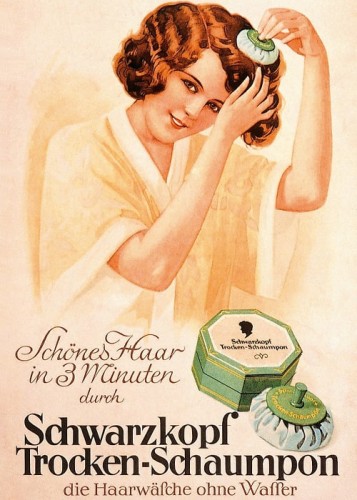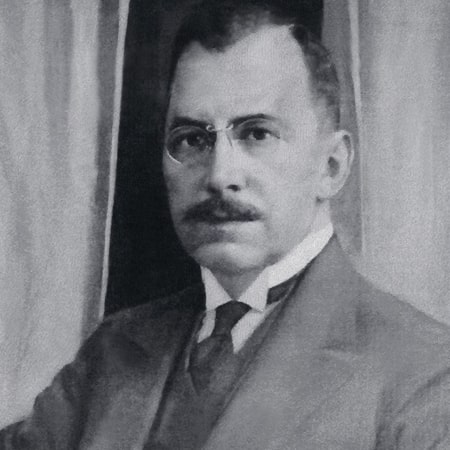What could be a better alternative than soap for washing hair? Here's the man who found that alternative: Hans Schwarzkopf
German chemist Hans Schwarzkopf didn't just create a new product type with the powder shampoo he invented in 1903. At the same time, he laid the foundations of the cosmetics industry.

Who is Hans Schwarzkopf? (1874-1921)
Hans Schwarzkopf was born in 1874 in Danzig, an independent city-state between the borders of Germany and Poland. His interest in the field of chemistry emerged from an early age. Therefore, he completed his higher education in the field of chemistry. In 1898 he opened a small pharmacy in Berlin. In terms of cosmetics history, this pharmacy would be the scene of a very important success in the future. The powder shampoo invented by Schwarzkopf in this pharmacy would open a whole new chapter not only in the field of hair care, but also in the history of cosmetics. As a matter of fact, in those years, pharmacies were not just places to sell drugs. At the same time, they were places where medicines were produced and met the various needs of people. Pharmacies were serving to meet many needs from cough syrup to strength syrups, from ointments to other care products. At the same time, many cleaning agents were sold in pharmacies. After the invention of soap, pharmacies became one of the most important addresses for access to soap. Soaps were used for both laundry cleaning and personal care.

Different materials have been used throughout history for hair cleaning and care. Of these, soda was one of the most widely used substances. In addition to soda, some plants were also giving good results in this regard. For example, when the gypsum plant combined with water, it foamed and provided the cleaning and care of the hair. With the invention of soap, many things started to change in the field of cleaning. At the same time, soap came to the fore in hair cleaning. At the beginning of the 20th century, soap and water preceded other cleaning agents. However, soap had harmful effects on the scalp due to its alkaline nature. The substances in the soap turned into a kind of lime when they combined with the ion in the water. As a result, the natural color of the hair was lost. Moreover, it was difficult to apply the soap to the hair. This difficulty was more in long hair. To overcome these difficulties, chemists developed solutions for rinsing soap with diluted acetic acid or citric acid. These were also sold in pharmacies. In the process, Hans Schwarzkopf developed a new solution that broke many of the rules.
Hans Schwarzkopf and Powder Shampoo
In the pharmacy he opened in Berlin in 1898, Hans Schwarzkopf was selling perfumes as well as medicines. One day, a customer stopped by his pharmacy to buy the hair cleaning solution used by the British. This is how Hans Schwarzkopf first became acquainted with such a product type. In other words, there was no hair cleaning solution in his pharmacy. He didn't know how to produce it either. Thereupon, his client asked if he could bring this solution from England. Hans Schwarzkopf did not have such an opportunity and therefore could not respond positively to the customer's request. Later, when the customer came with the same request several times, Schwarzkopf started to think about this product type. Although it was not possible to bring the solution from England, he had the opportunity to produce it in his own pharmacy. Thus, he began working on soap and soap solutions. After a few years of work, the first powder shampoo was presented to users in 1903. These products were both more successful and affordable compared to other solutions.
In the late 19th century, some hairdressers in England were using soap solutions as a better alternative to soap for cleaning hair. They prepared these solutions by boiling small pieces of soap with some herbs in water. The resulting liquid was easier to apply to the hair and allowed the hair to preserve its natural color. The natural plant extracts they used in the mixture prevented soap scales that caused the hair to lose its natural color. This method would also be a source of inspiration for the liquid shampoos we use today. In this way, Kasey Hebert produced the first shampoo. Hebert shampoos were used in hairdressing salons in England at the beginning of the 20th century and attracted the attention of the public. There were other shampoos produced commercially in England during this period. At the same time, other solutions to reduce the harm of soap for hair were the subject of research. But the powder shampoo, invented by Hans Schwarzkopf in 1903, was much more successful than soap solutions up to that time. Moreover, it was easy to use. To use powder shampoo, it was enough to dissolve it in water only.
Hans Schwarzkopf's powder shampoo was an important milestone in the birth of the cosmetics industry. As a matter of fact, after the success of the products, Schwarzkopf took a break from his pharmaceutical business and started working on new product types. He also explored what he could do to further improve powder shampoos. These products were especially successful in thin and normal hair. It was not yet suitable for oily scalps. In the early years of the 20th century, Hans Schwarzkopf was the first chemist to come to the conclusion that different types of shampoo should be used for different hair types. However, the distinction for hair types was not taken into account in the hair solutions that are still sold in the UK. For this reason, the products were successful only on normal hair types, but did not meet expectations on oily hair types. On the other hand, the British used sodium and sulfate in their products to cause the solution to foam. However, these ingredients were not present in Hans Schwarzkopf's powder shampoo. Despite this, the products foamed sufficiently, did not damage the natural color of the hair, and strengthened the scalp.
Hans Schwarzkopf, who further developed the formula of the shampoo over time, achieved many successes that gave the hair a shiny, full and supple appearance. It also made the shampoo easier to use. Users would shake the powder shampoo in the palm for a while first. Then they mixed it with water. After dissolving in water, they applied the shampoo to the hair just like today. It was sufficient to use only water for rinsing. There was no need for any other product to make the hair look shiny, full and flexible. However, many other hair solutions sold in the same period required different chemicals for rinsing. For this reason, it was difficult to use and additional costs were incurred. Those who did not want to cover this cost could choose to rinse their hair with vinegar or lemon water. Hans Schwarzkopf's powder shampoo provided a successful solution to all these difficulties and laid the foundations of hair care cosmetics. In the early years of the 1900s, these products became one of the most popular hair care products, especially among female customers.
Having achieved great success in hair care cosmetics, Hans Schwarzkopf saw the commercial results and potentials of his success in a short time. These shampoos, which ended the use of harsh soaps and expensive oils in hair cleaning, soon began to be sought in other pharmacies in Berlin. The achievements of Hans Schwarzkopf were also followed with interest by Fritz Henkel. Founded in 1876, Henkel & Cie had become one of Germany's most important players in the field of chemicals and paints. During this period, Schwarzkopf received the greatest support from Henkel. Although he achieved great success in the field of cosmetics, he did not have enough resources for mass production yet. Thanks to the commercial partnership he established with Henkel, Hans Schwarzkopf had the opportunity to deliver his shampoos to almost every corner of Germany. Moreover, he received orders from abroad. The first exports were made to Austria, Hungary and Switzerland. In this process, Hans Schwarzkopf began to spend most of his time in sales and marketing.
In 1917, Hans Schwarzkopf faced serious problems in continuing his business and sold his company to Henkel. Thus, he started to spend all his time with P&D processes again. After powder shampoo, Schwarzkopf's most important achievement was producing low alkali soap. When he died in Berlin in 1921, he left behind very important chemical studies. Following in the footsteps of Hans Schwarzkopf, chemists Schwarzkopf and Henkel launched the first liquid shampoo in 1927. In these shampoos, soaps with low alkaline degree were used, produced by the methods developed by Hans Schwarzkopf. These soaps, one of the most important achievements after the invention of soap, opened a new page in the field of skin care. After seeing that these products can be used for hand care, the first hand cream was launched. Hand creams, sold in small tubes, remained one of the most popular products in the hand care category until the 1960s. In the following process, it turned out that ether sulfates gave better results in skin care. Thereupon, the Schwarzkopf brand went through some changes in its cosmetic products.
